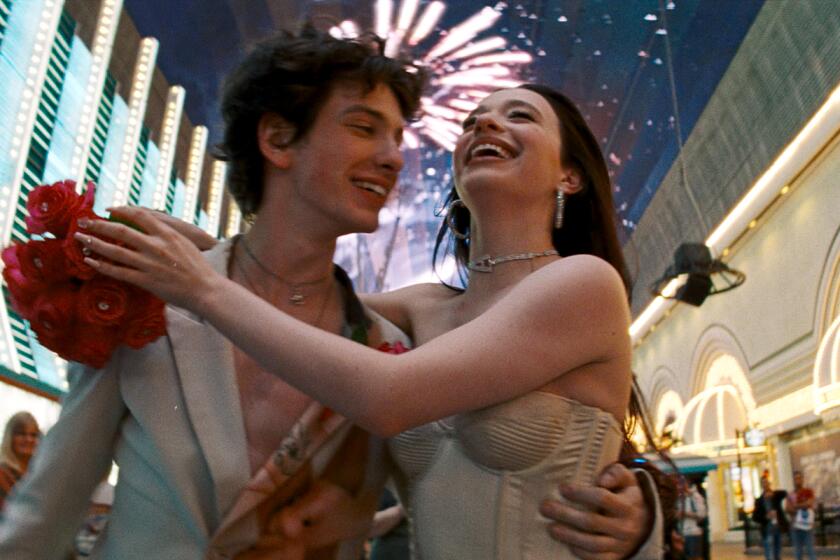The Way He Is and Always Was
- Share via
NEW YORK — A blue sky, a blue breeze and a yellow cab, carrying its fare to a Saturday morning interview with Robert Redford, hurtles along Park Avenue--and hits about 30 green lights in a row. Now, the obvious question for the passenger should have been: Has the world come to an end? Has the vehicular population of Manhattan been beamed aboard that alien space vessel moored over New Jersey?
No. Just another marathon, creating a traffic tourniquet somewhere to the south.
What seems really strange, though, is the sudden recollection of a December 1974 Playboy interview with a 37-year-old screen star named Robert Redford. In it, Redford recounted his own quixotic attempt as a very young man to beat the lights on Park Avenue, piloting his sports car on an ever-accelerating quest toward something elusive, almost mythical--and, had the Motor Vehicle Department of the City of New York been consulted, definitely illegal.
“In those days there was just the Grand Central building, before the Pan Am was built. It was 1962,” says Redford 2000, having entered the Manhattan hotel room smiling, blond, trim, casual, a bit craggy at 63 but pretty much as you expected. “And I just went for it. And you build up a certain speed when you go for something sometimes. You go out of control. It’s like ‘I can’t stop myself--somebody stop me, ‘cause I can’t stop myself!’ I said, ‘I’m going all the way with this thing.’ ”
And he almost did, until his car went into what he called a “controlled two-wheeled slide,” and almost wiped out at Vanderbilt Avenue.
For those who’ve followed Redford’s career (which by 1962 had included a “Twilight Zone” episode and something called “War Hunt”), the idea of a Robert Redford out of control evokes cognitive dissonance. His private life has been below the radar: He may spend most of his time now in Utah or the Napa Valley, but he raised a family in New York and his presence there was hardly a presence at all. His carefully cultivated superstardom has made the actor-director-producer a kind of totem in the annals of Hollywood stereotyping. Robert Redford, after all, always has been Robert Redford--the way Gable was Gable, Cooper was Cooper, William Powell was William Powell.
Redford is his own man, and his own model, too--and he doesn’t deviate from it much. Younger stars may push the envelope--Tom Cruise has done “Magnolia” and “Eyes Wide Shut,” Brad Pitt “12 Monkeys” and even Matt Damon--seemingly the most Redfordian of them all--was in “The Talented Mr. Ripley,” although his sexually ambivalent homicidal maniac was the most sympathetic sociopath you had ever seen.
Damon, not coincidentally, is the star of “The Legend of Bagger Vance.” The film, which opens Friday, is Redford’s sixth as a director--the area of Redford’s career where he really has stretched. In the Oscar-winning “Ordinary People” (1980) or the much-honored “Quiz Show” (1994) or even his last, “The Horse Whisperer” (1998), Redford exhibits more daring than he ever did in his choice of movie roles--although nobility, or a grasping for nobility, is afoot in all his work.
In “Bagger Vance,” a Jazz Age golden boy (Damon), a wizard of the links, goes off to World War I, has his ideals shot out from under him and returns a broken man. With the aid of a mysterious caddie named Bagger (Will Smith), he strives to regain his swing, his soul and his girl (Charlize Theron).
Redford did fly fishing in “A River Runs Through It” (1992). Maybe a movie about golf is not so strange. And maybe golf isn’t the attraction at all.
“No, that would not interest me,” Redford says. “First of all, it’s everywhere. It’s ubiquitous. You turn on the Golf Channel. Airlines. It’s everywhere.”
Some would suggest that’s just the reason to do it.
“Yeah, but it wouldn’t be mine,” he says. “But golf as a metaphor for life does interest me.”
Wanted to Do Something Uplifting
“Bagger Vance” is based on a novel by Steven Pressfield (screenplay by Jeremy Leven) and what Redford found in it was the way to create a story in a classic form: the hero’s fall into darkness, from grace, and his struggle to return to the light. Pressfield, Redford says, borrowed heavily from the Bhagavad-Gita and other Eastern sources, as well as Western mythology “and the part that interested me was the part that related to the character’s battle with himself, the idea of focus, concentration, center, what we now hear of as ‘the zone’--the way an athlete gets into the zone.”
“I was intrigued by that. And I saw that the book was full of wonderful raw material. That’s how I saw it. I don’t know that I would ever be so interested in doing a book verbatim. I’d have to make it my own somehow.”
He also needed a break after the gravity of “The Horse Whisperer.”
“I was looking for something uplifting, as much for myself as anything else. Because that was a heavy trip. Even though it had some positive aspects to it, it was about healing, it involved damaged animals, children, and was a hard, heavy movie to make.
“So I thought next time, I’d like to do something quirky. Entertaining but quirky. . . . And also, the whole atmosphere up there at the festival, I could see things were getting darker and darker, more and more cynical. I thought, maybe it’s not a bad idea to do something kind of uplifting.”
The festival, of course, is Sundance, with which Redford has been involved since the mid-’80s, when his Sundance Institute (he was, after all, the Sundance Kid) took over the existing U.S. Film Festival. His presence there has been erratic, almost shadowy; in an effort not to eclipse the festival’s filmmakers, he has become its resident phantom.
“To be honest with you? It would be nice, just for my ego, for people to know how hard I work on it,” Redford says. “I spend a lot of time on it, preparing for it every year, and we always have a post-mortem afterwards, taking a hard look at what went wrong, or what could have been better. Refining it.
“And, of course, starting it was not an easy thing,” he adds. “For three years, nobody was even interested.
“For those years, I would literally stand out on the corner and collar people to get them into theaters. I remember going to David Puttnam when he was at Columbia and saying, ‘I want you to come see “The Big Easy” ’--I just liked Jim McBride’s early work and I knew McBride had had a really rough go, hadn’t made a film in a few years. So I dragged Puttnam in there, literally forced him into the theater.”
Puttnam bought the movie. “And that was the first big buy at the festival,” Redford says.
And almost immediately, Redford started taking a backseat “because I thought, ‘If it’s going to go it’ll go on its own.’ And when it did I was really thrilled. I thought, ‘This is great. I can just go watch the movies.’
“It’s a great chance for me to watch movies, meet the filmmakers. That’s the biggest joy for me, meeting the filmmakers.”
Fleshing Out ‘Bagger Vance’
Redford is himself, of course, an independent filmmaker, one with carefully wrought ideas and a genuine cinematic palette: The opening sequence in “Horse Whisperer,” for example, is an elegiac daydream of half tones and impressionism; “Quiz Show” re-creates its era of early TV with effortless grace.
In “Bagger Vance,” the mood and tones change as fast and furiously as the story elements, which set up the film with a kind of ragtime staccato that suggests “The Sting.”
“I didn’t think ‘The Sting,’ but you’re right,” Redford says. “I wanted to do it like an old ‘30s movie, high-energy, fast-paced, full of life, very Chekovian, the rug being pulled out constantly from people. ‘Oh, we’re going this way? No, we’re goin’ that way. . . .’ That’s fun for me and I wanted to do something with more humor.
“So when I was preparing, I thought, ‘I have a hell of a deal here. I have to set up Bagger Vance, set up the narrator looking back on himself as a boy, the townsfolk, the conditions under which the hero falls into darkness, the First World War--can’t spend much time there ‘cause it’s not about the war, but you have to have it--plus you have to set up the romantic element by showing how the couple was perfect at one time, the boy’s relationship with his father and his family. There’s a whole lot of stuff going down there.’
“I thought, ‘How am I going to do it?’ And I thought the only way was to compress it and have it almost like a title sequence, like a preface, where you say to the audience, we’re not going to stop anywhere very long.”
The war sequence? “Well, with [cinematographer] Michael Ballhaus, I shot in 8mm, step-frame, 16mm, 35mm, slow-mo. I threw everything in there to create an impressionistic feel for that war in one minute, which is all it lasts in the film.”
An Inspiring ‘Authentic Swing’
He also had to set up the characters of Bobby Jones (Joel Gretsch) and Walter Hagen (Bruce McGill), two of the greatest golfers of their age and polar opposites in temperament--Jones the Righteous, Hagen the Moral Reprobate, both of whom are hornswoggled into playing a benefit match for the Depression-besieged golf resort of Adele Invergordon (Theron). Under pressure from the town fathers, Adele also has to include a local entry in her tournament, Rannulph Junuh, Damon’s tarnished golden boy, Adele’s ex and a golfer who, according to Bagger, has lost his “authentic swing.”
“What really got me, when I heard the story being told, was the phrase ‘the authentic swing,’ ” Redford says. “Somehow, it’s this quirky thing, how you approach a piece of work: Sometimes it’s just a word, a phrase; sometimes it’s the turning of a corner.”
“Bagger Vance,” Redford says, was a chance to get even more into visual storytelling, using single images that would carry a lot of story, like the comic strips he followed when he was a kid, growing up in Santa Monica, the son of a milkman.
“That was one of the few entertainments I had,” Redford says. “Well, I had radio. But we were a pretty working, lower-class family where there wasn’t a lot. We were in a Mexican neighborhood. It was fairly grim. There were no class distinctions, because we wereunited by the war effort. These weren’t happy times; nobody had much. The library’s where I got into this mythology. But how the people came together was radio, or the funny papers. Sunday was a huge deal. You’d go racing for the funnies. Without knowing it, I was very connected to them.”
Redford has directed a half-dozen films, starred in scores more. But if one had to guess, and not guess too hard, it would be directing that has his heart.
“Originally,” he says, “when I first got involved in ‘Bagger Vance’ I thought of it as something I would be in. But very quickly I decided against that because when I got into it and started to read the book it had too many parallels to ‘The Natural.’ I’ve sort of been there.
“And I was more interested in a younger cast because it might be more affecting to have this happen to a very young person. It reminded me of a poem by A.E. Houseman called ‘A Shropshire Lad,’ an ode to an athlete who dies young. I remembered being very moved by the fact that this guy goes out in a moment of glory, and maybe that was the best time to go out, ‘cause after that it’s all downhill. . . .”
What Houseman’s bygone athlete should have done, of course, is go into a controlled two-wheeled slide, hit the gas and not stop till he saw the Hollywood Hills.
More to Read
Only good movies
Get the Indie Focus newsletter, Mark Olsen's weekly guide to the world of cinema.
You may occasionally receive promotional content from the Los Angeles Times.









